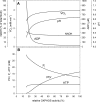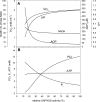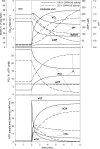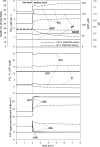Faster and stronger manifestation of mitochondrial diseases in skeletal muscle than in heart related to cytosolic inorganic phosphate (Pi) accumulation
- PMID: 27283913
- PMCID: PMC5007323
- DOI: 10.1152/japplphysiol.00358.2016
Faster and stronger manifestation of mitochondrial diseases in skeletal muscle than in heart related to cytosolic inorganic phosphate (Pi) accumulation
Abstract
A model of the cell bioenergetic system was used to compare the effect of oxidative phosphorylation (OXPHOS) deficiencies in a broad range of moderate ATP demand in skeletal muscle and heart. Computer simulations revealed that kinetic properties of the system are similar in both cases despite the much higher mitochondria content and "basic" OXPHOS activity in heart than in skeletal muscle, because of a much higher each-step activation (ESA) of OXPHOS in skeletal muscle than in heart. Large OXPHOS deficiencies lead in both tissues to a significant decrease in oxygen consumption (V̇o2) and phosphocreatine (PCr) and increase in cytosolic ADP, Pi, and H(+) The main difference between skeletal muscle and heart is a much higher cytosolic Pi concentration in healthy tissue and much higher cytosolic Pi accumulation (level) at low OXPHOS activities in the former, caused by a higher PCr level in healthy tissue (and higher total phosphate pool) and smaller Pi redistribution between cytosol and mitochondria at OXPHOS deficiency. This difference does not depend on ATP demand in a broad range. A much greater Pi increase and PCr decrease during rest-to-moderate work transition in skeletal muscle at OXPHOS deficiencies than at normal OXPHOS activity significantly slows down the V̇o2 on-kinetics. Because high cytosolic Pi concentrations cause fatigue in skeletal muscle and can compromise force generation in skeletal muscle and heart, this system property can contribute to the faster and stronger manifestation of mitochondrial diseases in skeletal muscle than in heart. Shortly, skeletal muscle with large OXPHOS deficiencies becomes fatigued already during low/moderate exercise.
Keywords: OXPHOS deficiency; heart; inorganic phosphate; mitochondrial disease; skeletal muscle; tissue specificity.
Copyright © 2016 the American Physiological Society.
Figures






References
-
- Allen DG, Lamb GD, Westerblad H. Skeletal muscle fatigue: cellular mechanisms. Physiol Rev 88: 287–332, 2008. - PubMed
-
- Balaban RS, Kantor HL, Katz LA, Briggs RW. Relation between work and phosphate metabolite in the in vivo paced mammalian heart. Science 232: 1121–1123, 1986. - PubMed
-
- Benard G, Faustin B, Passerieux E, Galinier A, Rocher C, Bellance N, Delage JP, Casteilla L, Letellier T, Rossignol R. Physiological diversity of mitochondrial oxidative phosphorylation. Am J Physiol Cell Physiol 291: C1172–C1182, 2006. - PubMed
-
- Bessman SP, Geiger PJ. Transport of energy in muscle: the phosphorylcreatine shuttle. Science 211: 448–452, 1981. - PubMed
-
- Brandes R, Bers DM. Intracellular Ca2+ increases the mitochondrial NADH concentration during elevated work in intact cardiac muscle. Circ Res 80: 82–87, 1997. - PubMed
Publication types
MeSH terms
Substances
LinkOut - more resources
Full Text Sources
Other Literature Sources
Medical
Research Materials
Miscellaneous

